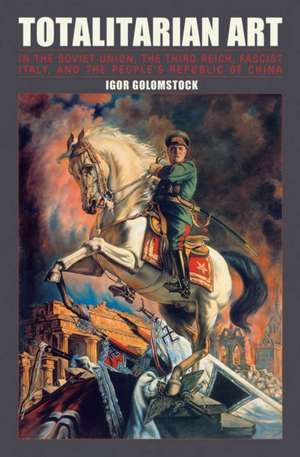Totalitarian Art: In the Soviet Union, the Third Reich, Fascist Italy and the People's Republic of China
Autor Igor Golomstock Traducere de Robert Chandleren Limba Engleză Paperback – 30 sep 2012 – vârsta de la 18 ani
In Totalitarian Art, artist and university professor Igor Golomstock presents a history of the images and themes used by authoritarian governments and nations.
In the Soviet Union, and later in Maoist China, theories of mass artistic appeal were used to promote the Revolution both at home and abroad. In Nazi Germany and Fascist Italy they asserted the putative grandeur of the epoch. All too often, art that served the Revolution became “total realism,” and always it became a slave to the state and the cult of personality, and ultimately one more weapon in the arsenal of oppression.
Igor Golomstock gives a detailed appraisal of the forms that define totalitarian art and illustrates his text with more than 200 examples of its paintings, posters, sculpture, and architecture, and includes a powerful comparative visual essay which demonstrates the eerie similarity of the official art of these very different regimes.
In the Soviet Union, and later in Maoist China, theories of mass artistic appeal were used to promote the Revolution both at home and abroad. In Nazi Germany and Fascist Italy they asserted the putative grandeur of the epoch. All too often, art that served the Revolution became “total realism,” and always it became a slave to the state and the cult of personality, and ultimately one more weapon in the arsenal of oppression.
Igor Golomstock gives a detailed appraisal of the forms that define totalitarian art and illustrates his text with more than 200 examples of its paintings, posters, sculpture, and architecture, and includes a powerful comparative visual essay which demonstrates the eerie similarity of the official art of these very different regimes.
Preț: 188.07 lei
Nou
Puncte Express: 282
Preț estimativ în valută:
35.99€ • 39.08$ • 30.23£
35.99€ • 39.08$ • 30.23£
Carte indisponibilă temporar
Doresc să fiu notificat când acest titlu va fi disponibil:
Se trimite...
Preluare comenzi: 021 569.72.76
Specificații
ISBN-13: 9781590206706
ISBN-10: 1590206703
Pagini: 420
Dimensiuni: 155 x 231 x 36 mm
Greutate: 0.75 kg
Ediția:2nd ed.
Editura: Overlook Press
Locul publicării:New York, United States
ISBN-10: 1590206703
Pagini: 420
Dimensiuni: 155 x 231 x 36 mm
Greutate: 0.75 kg
Ediția:2nd ed.
Editura: Overlook Press
Locul publicării:New York, United States
Recenzii
"Important and encyclopedic tome...Totalitarian Art is an indispensable work of reference."--"Foreign Affairs"
"Golomstock convincingly demonstrates how the overlapping aesthetic values of these superficially disparate regimes underlined how much they had in common Fascinating." "Wall Street Journal"
"Important and encyclopedic tome Totalitarian Art is an indispensable work of reference. "Foreign Affairs""
"Golomstock convincingly demonstrates how the overlapping aesthetic values of these superficially disparate regimes underlined how much they had in common Fascinating." "Wall Street Journal"
"Important and encyclopedic tome Totalitarian Art is an indispensable work of reference. "Foreign Affairs""
Notă biografică
Igor Golomstock was a member of the Union of Soviet Artists and worked at the Pushkin Museum. He has taught at the Universities of St.Andrews, Essex and Oxford.
Robert Chandler is the translator of Vasilii Grossman's "Life and Fate," and of Andrei Platonov's "The Foundation Pit."
Robert Chandler is the translator of Vasilii Grossman's "Life and Fate," and of Andrei Platonov's "The Foundation Pit."
Descriere
"Totalitarian Art" achieves nothing less than a thorough and serious comparative study of the official art of Stalin s Russia, Hitler s Germany, Mussolini s Italy, and Mao s China.
In the Soviet Union, and later in Maoist China, theories of mass artistic appeal were used to promote the Revolution both at home and abroad. In Nazi Germany and Fascist Italy they asserted the putative grandeur of the epoch. All too often, art that served the Revolution became "total realism," and always it became a slave to the state and the cult of personality, and ultimately one more weapon in the arsenal of oppression. Igor Golomstock gives a detailed appraisal of the forms that define totalitarian art and illustrates his text with more than two hundred examples of its paintings, posters, sculpture, and architecture, and includes a powerful comparative visual essay which demonstrates the eerie similarity of the official art of these very different regimes."
In the Soviet Union, and later in Maoist China, theories of mass artistic appeal were used to promote the Revolution both at home and abroad. In Nazi Germany and Fascist Italy they asserted the putative grandeur of the epoch. All too often, art that served the Revolution became "total realism," and always it became a slave to the state and the cult of personality, and ultimately one more weapon in the arsenal of oppression. Igor Golomstock gives a detailed appraisal of the forms that define totalitarian art and illustrates his text with more than two hundred examples of its paintings, posters, sculpture, and architecture, and includes a powerful comparative visual essay which demonstrates the eerie similarity of the official art of these very different regimes."
